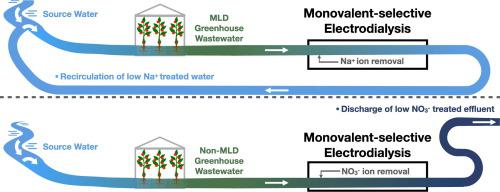Desalination ( IF 9.9 ) Pub Date : 2021-03-14 , DOI: 10.1016/j.desal.2021.115037 Yvana D. Ahdab , Georg Schücking , Danyal Rehman , John H. Lienhard

|
Minimal liquid discharge (MLD) in greenhouses minimizes the volume of discharged wastewater, thereby increasing the volume of effluent that may be reused. Sodium accumulation in wastewater is often considered the main bottleneck to achieving 100% reuse. Consequently, greenhouses have begun adopting reverse osmosis (RO), the most commonly used desalination technology for wastewater treatment. RO removes ions from wastewater indiscriminately, including multivalent nutrients to crops (Ca2+, Mg2+, SO42−, PO43−). In contrast, monovalent selective electrodialysis (MSED) selectively removes monovalent sodium while retaining multivalent nutrients in solution. For greenhouses that have not achieved MLD, MSED has an alternative application of reducing levels of nitrate, a monovalent ion and agricultural pollutant, in wastewater for disposal. This paper investigates the monovalent selectivity and potential of the widely-used Neosepta MSED membranes and the new Fujifilm MSED membranes to treat wastewater in greenhouses for reuse or discharge. Eight effluent compositions are tested as feedwater in a laboratory MSED system. Both membranes demonstrate selectivity towards sodium and nitrate across the tested compositions. Fujifilm cation-exchange membranes remove two to six sodium ions, compared to Neosepta's two to eight, for every magnesium ion. Fujifilm anion-exchange membranes remove two to seven nitrate ions, compared to Neosepta's two to six, for every sulfate ion.
中文翻译:

使用单价选择性电渗析处理温室废水以供再利用或处理
温室中最小的液体排放量(MLD)可使排放的废水量最小化,从而增加了可重复利用的废水量。废水中的钠积累通常被认为是实现100%再利用的主要瓶颈。因此,温室已经开始采用反渗透(RO),这是用于废水处理的最常用的脱盐技术。RO可以无差别地从废水中去除离子,包括对作物的多价养分(Ca 2 +,Mg 2 +,SO 4 2-和PO 4 3-)。相反,单价选择性电渗析(MSED)选择性去除单价钠,同时将多价营养物保留在溶液中。对于未达到MLD的温室,MSED可以选择减少废水中硝酸盐,一价离子和农业污染物的含量。本文研究了广泛使用的Neosepta MSED膜和新型Fujifilm MSED膜用于处理温室废水中的回用或排放的单价选择性和潜力。在实验室MSED系统中测试了八种废水成分作为给水。两种膜均显示出在整个测试组合物中对钠和硝酸盐的选择性。与Neosepta的2至8个镁离子相比,Fujifilm阳离子交换膜可去除2至6个钠离子。



























 京公网安备 11010802027423号
京公网安备 11010802027423号